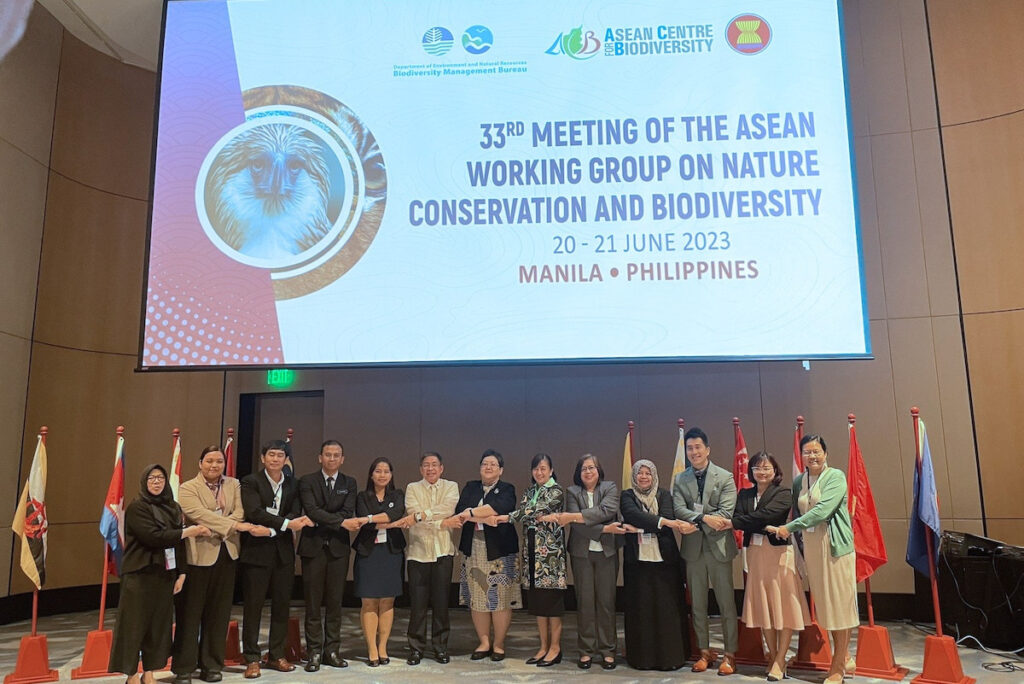The 10-nation political and economic bloc, the Association of Southeast Asian Nations (Asean), met in Pasay City, Philippines for a two-day meeting to map out its actions for nature in line with the new set of global biodiversity targets or the Kunming-Montreal Global Biodiversity Framework.
Hosted and chaired by the Philippines through the Department of Environment and Natural Resources-Biodiversity Management Bureau (DENR-BMB), with support from the Asean Secretariat and the Asean Centre for Biodiversity (ACB), the 33rd Meeting of the Asean Working Group on Nature and Conservation and Biodiversity (AWGNCB) gathered key Asean policymakers from 20 to 21 June 2023 to discuss how the rich biodiversity in the region can be protected and sustainably used to contribute to the resiliency, recovery, and economic development in Southeast Asia.
The AWGNCB was established to boost collaboration in resolving issues related to the conservation and sustainable utilisation of biological resources in the region. Following the practice of Asean on the rotational hosting of its member states for its meetings, the last time the same body met in the Philippines was in 2013 and the next will be after ten years or in 2033.
DENR-BMB assistant secretary Marcial Amaro, Jr., who served as the meeting chair, stressed the importance of regional cooperation and the role of AWGNCB in the implementation of 23 new global biodiversity targets that were adopted in 2022. He likewise urged intensified collective efforts since biodiversity challenges transcend geographical borders.
“There are targets such as restoration of degraded ecosystems that require connectivity to enhance ecosystem functions and services. The use, harvest and trade of wild species necessitate cross-border cooperation to minimise overexploitation and reduce risk of pathogen spillovers. The impacts of climate change cannot be mitigated within geographical territories alone, global action is imperative. Monitoring, assessing, and reporting compliance of large, transnational companies and financial institutions entail cooperation among AMS for full disclosure of risks, dependencies, and impacts on biodiversity,” he said.
Apart from the Asean member states, representatives from the region’s dialogue and development partners, such as the Deutsche Gesellschaft für Internationale Zusammenarbeit (GIZ), Enhanced Regional EU-Asean Dialogue Instrument, GITEC-IGIP GmbH, Ministry of Environment of Japan, and Hanns Seidel Foundation participated in the open session of the meeting.
Some of the highlights of the discussions were the newly declared and nominated Asean Heritage Parks; updates on regional biodiversity programmes and projects such as the EU-supported Biodiversity Conservation and Management of Protected Areas in Asean, the ACB-KfW Small Grants Programme, and the Institutional Strengthening of the Biodiversity Sector in Asean supported by the GIZ; the new set of Asean Biodiversity Heroes; results of the first cycle of the Asean Green Initiative; outcomes of the 15th UN Biodiversity Conference; and the region’s ways forward in the achievement of the global biodiversity targets. The youth, represented by the Youth Biodiversity Leaders, likewise participated in the discussions by presenting the next steps for the Asean Youth Biodiversity Programme that was recently institutionalised by the ACB.
ACB Executive Director Dr Theresa Mundita S. Lim reiterated the importance of regional cooperation, and cross-sectoral and cross-pillar collaboration in maximising the value of biological resources to benefit the Asean community and thanked the Philippine government for its leadership in advancing the region’s biodiversity mainstreaming and sustainable development agenda.
Source : Eco-Business


